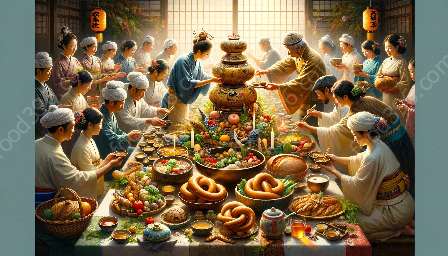Food plays a significant role in religious ceremonies and rituals, serving as a symbolic expression of faith, tradition, and community. Throughout history, different cultures have incorporated food symbolism into their religious practices, reflecting their values, beliefs, and cultural heritage.
Understanding Food Rituals and Symbolism
Food rituals and symbolism are deeply ingrained in religious traditions and are often associated with spiritual significance and meaning. The act of sharing and consuming food in a religious context goes beyond nourishment and sustenance; it is a way to express devotion, gratitude, and unity within a community.
Many religious traditions incorporate specific foods and meals into their ceremonies to symbolize key aspects of their faith, such as rebirth, sacrifice, purification, and communion with the divine. These symbolic foods are often rich in cultural and historical significance, connecting the present-day practices with age-old traditions.
The Cultural Significance of Food in Religious Ceremonies
Food culture and history are closely intertwined with religious practices, highlighting the diverse ways in which food symbolism is used to convey spiritual and metaphysical concepts. From the Eucharist in Christianity to the Seder meal in Judaism and the Prasad offerings in Hinduism, food serves as a tangible representation of religious beliefs and traditions.
Each religious tradition has its unique food symbolism and rituals, often rooted in historical contexts and cultural narratives. The use of specific ingredients, preparation methods, and communal dining practices contribute to the rich tapestry of food symbolism in religious ceremonies.
Exploring Food Symbolism in Different Religious Traditions
Christianity: In Christianity, the Eucharist, or Holy Communion, plays a central role in religious ceremonies. The consumption of bread and wine symbolizes the body and blood of Christ, representing the spiritual nourishment and unity of believers in Christ's sacrifice.
Judaism: The Passover Seder meal, with its symbolic foods such as matzo, bitter herbs, and charoset, embodies the story of the Israelites' liberation from slavery in ancient Egypt. Each food item carries specific meanings and is part of the retelling of the Exodus narrative.
Hinduism: The offering of Prasad, sanctified food blessed by deities, is a common practice in Hindu religious ceremonies. Devotees receive this food as a form of divine grace and blessing, underscoring the connection between the material and spiritual realms.
- Buddhism: Buddhist traditions often include the ritual offering of food to monks and the Buddha. This act of generosity and generosity symbolizes the virtues of compassion, gratitude, and interconnectedness in Buddhist teachings.
- Islam: The breaking of the fast during Ramadan, known as Iftar, involves the consumption of date fruits and water, following the tradition of Prophet Muhammad. This act symbolizes gratitude, compassion, and solidarity within the Muslim community.
Food Symbolism as a Reflection of Cultural Values
Food symbolism in religious ceremonies provides a window into the cultural values and beliefs of different communities. The preparation and consumption of symbolic foods are often accompanied by rituals, prayers, and communal gatherings, reinforcing cultural identity and shared heritage.
These food rituals also serve as a way to pass down traditions from one generation to another, preserving the collective memory and spiritual significance of certain foods and meals. They foster a sense of belonging and continuity within religious communities, forging connections between the past, present, and future.
The Historical Legacy of Food Symbolism
The history of food symbolism in religious ceremonies is rooted in ancient practices and narratives, reflecting the evolution of religious beliefs and cultural exchanges over time. From sacrificial offerings in ancient civilizations to the establishment of certain dietary laws and customs, food has been an integral part of religious expression and identity.
As communities migrated and interacted with one another, food symbolism and rituals were influenced by diverse cultural and geographical contexts, resulting in a rich tapestry of traditions and practices. The fusion of food culture and religious beliefs has given rise to unique culinary traditions and customs that continue to define religious experiences and expressions.
Embracing Diversity in Food Symbolism
Food symbolism in religious ceremonies reflects the diversity of human experiences and beliefs, demonstrating the myriad ways in which food can serve as a conduit for spiritual and cultural expression. Each religious tradition brings its distinctive practices and symbolism, enriching the global tapestry of food culture and history.
By understanding the significance of food in religious ceremonies, we can gain a deeper appreciation for the cultural and spiritual dimensions of food, transcending mere sustenance and nourishment. It invites us to embrace diversity, foster interfaith dialogue, and celebrate the universal human experience of sharing and consuming food as a sacred act.

